What to Wear
On this page you will find clothing lists: Women’s Pioneer Clothing, Men’s Pioneer Clothing, Shoe guidelines for men and women, General Clothing (swimsuit info included), and what not to bring on Trek. Please read through all lists below.
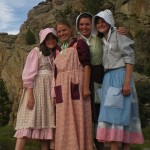
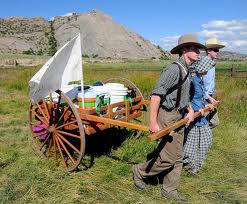

PIONEER CLOTHING
The clothing worn by the pioneers was a combination of the fashions of the era and fabrics that had to withstand the constant challenges of the elements; rainstorms, prairie fires and blizzards along with the demands of daily Trek life. Wearing pioneer clothing styles during the Trek adds to the spirit and authenticity of the experience and it is fun!
Prepare now to attire yourself in proper period clothing during the Trek. The spending of excessive money and time on your pioneer clothing is strongly discouraged
- Begin by speaking with your family and finding out if any members of your family have clothing that you can wear on the Trek.
- Let the Relief Society and Priesthood know of the Pioneer clothing need of the YM and YW. Ward clothing donations as well as cotton fabric will help as your youth begin assembling their outfits.
- Local thrift stores can be a resource in finding period clothing from the Pioneer Era.
- Sew the clothing yourself! Organize a group-sewing day with skilled Relief Society sisters or as a mid-week activity.
- Purchasing clothing from companies who specialize in Pioneer clothing can be costly. It is suggested that you use this as a last resort.
- As you select your Pioneer clothing fabrics, keep in mind how hot and humid the weather in New England can get during the month of August. We recommend lightweight cottons and natural fiber materials.
GENERAL PIONEER CLOTHING
Shoes
Shoes for both Men and Women need not be “period” style. Comfort is most important. Sneakers work well. Do not wear new hiking boots or western style boots unless you have taken at least two months to break them in. Bring two pair, so if one gets wet or cause blisters, the other pair can be worn.
General Clothing
- Pack clean socks for each day
- 1 Extra long-sleeved shirt (no t-shirts)
- 1 Rain poncho (pack on top for easy access)
- 1 Lightweight jacket or sweatshirt (no logos)
- 1 Pair sweats or modest pajamas to sleep in
- 2 Sets of underwear
Swimwear
Bring modest swimwear (following the For the Strength of Youth Standards). Young Women, 1-piece bathing suits only.
Here is a good article with 1-piece bathing suit ideas: http://ldsliving.com/story/68637-lifestyle-ultimate-guide-modest-swimsuits-2012
Other
- 1 Pair work gloves (leather or canvas)
WOMEN’S PIONEER CLOTHING
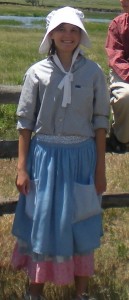
You will need a total of 2-3 (preferably 3) outfits comprised of the following combinations:
Blouses: Long-sleeved white/light colored button-down blouses. Sleeves are long, but can be either narrow or full with buttons or bands at the wrists. Necklines could be high with buttons up the front or end at the base of your neck. Cotton fabrics in solid colors or small prints.
Skirts: Lightweight fabrics. Solids/small prints or checks. Length of skirts/dresses= Mid-Calf length, to avoid tripping on the skirt during the Trek.
Dresses: Following the same criteria as the blouses and skirts.
Apron: The standard apron was six inches shorter than your skirt length. It was gathered at the waist and tied. The bib attached at the waist and was pinned to the dress bodice at the top two corners. Hence, the name pinafore (Pinned at two of the four corners) Daytime aprons were made of calico remnants. Sunday aprons were made from white fabric and did not have a bib. For trekking today, large deep pockets are important to be able to carry different items along the trail. Here’s a pattern you can use: http://handcart-trek.org/patterns/Aprons.pdf
Bonnet: Women wore bonnets whenever they were outside to protect head, scalp, ears, neck and face. Typically, your bonnet will not match your dress or apron. Choose a bonnet that is light in both weight and color.
Shawl: to keep away the evening or early morning chill, a simple 60-inch square of printed or plain cloth folded in a triangle.
Pantaloons/Bloomers:Wearing pantaloons helps maintain modesty in trekking situations and also to keep your legs from chafing when walking. These end just below the skirt/dress length. You could also wear knee-length shorts, summer length pajama bottoms or lightweight capris. Pantaloons will add another layer to your clothing so keep this in mind as you select your fabric. Hospital pants are no longer suggested as they are too heavy for New England summer weather
MEN’S PIONEER CLOTHING
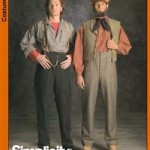
You will need a total of 2-3 (preferably 3) outfits comprised of the following combinations:
Men’s shirts: Long, loose sleeves, cotton, light in color and weight. Choose something larger than a regular fit, a banded collar if possible. Plain colors were common, but pin stripes or plaids were also used. The shirt should be tucked into the trousers.
Pants: Trekkers in our day find that wool is too hot but that cotton works great. Dockers style pants with colors that include blue, black, gray, browns, especially beige and tan. Choose rather loose fitting through the crotch and thigh area to add comfort in walking.
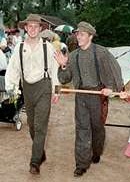
Suspenders (Braces): Men’s pants were held up by suspenders that were buttoned on the outside of the waistband and crossed in the back. Suspenders that button on the waistband were a common accessory. The rope belt is also an option.
Hat: Men’s everyday hats ranged from straw hats, wide-brimmed low felt hats, round crowned hat, known as a mechanics hat or a wheel cap, we refer to them as news boy hats.
Tie (optional): Usually vests/ties were worn only when attending a meeting or social event or on Sunday. Ties were small, black and silky, wrapped around the neck once and tied in the front with a square knot. Vests and Ties are optional, but nice for the dance.
WHAT NOT TO WEAR
- Blue jeans (Sorry, Levi Strauss didn’t get his U.S. patent until 1873)
- baseball caps
- tank tops
- t-shirts tight/short dresses
- brand new shoes